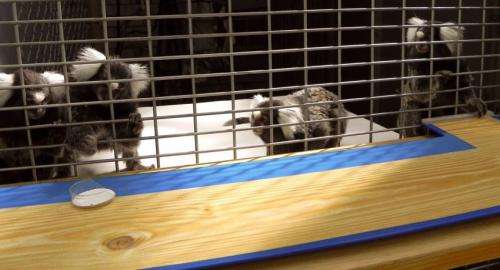The roots of human altruism

Scientists have long been searching for the factor that determines why humans often behave so selflessly. It was known that humans share this tendency with species of small Latin American primates of the family Callitrichidae (tamarins and marmosets), leading some to suggest that cooperative care for the young, which is ubiquitous in this family, was responsible for spontaneous helping behavior. But it was not so clear what other primate species do in this regard, because most studies were not comparable.
A group of researchers from Switzerland, Germany, Austria, Italy and Great Britain, headed by anthropologist Judith Burkart from the University of Zurich, therefore developed a novel approach they systematically applied to a great number of primate species. The results of the study have now been published in Nature Communications.
For their study, Burkart and her colleagues developed the new paradigm of group service, which examines spontaneous helping behavior in a standardized way. With the aid of a simple test apparatus, the researchers studied whether individuals from a particular primate species were prepared to provide other group members with a treat, even if this meant missing out themselves (see box). The scientists applied this standardized test to 24 social groups of 15 different primate species. They also examined whether and how kindergarten children aged between four and seven acted altruistically.
The researchers found that the willingness to provision others varies greatly from one primate species to the next. But there was a clear pattern, as summarized by Burkart: "Humans and callitrichid monkeys acted highly altruistically and almost always produced the treats for the other group members. Chimpanzees, one of our closest relatives, however, only did so sporadically." Similarly, most other primate species, including capuchins and macaques, only rarely pulled the lever to give another group member food, if at all – even though they have considerable cognitive skills.
Until now, many researchers assumed that spontaneous altruistic behavior in primates could be attributed to factors they would share with humans: advanced cognitive skills, large brains, high social tolerance, collective foraging or the presence of pair bonds or other strong social bonds. As Burkart's new data now reveal, however, none of these factors reliably predicts whether a primate species will be spontaneously altruistic or not. Instead, another factor that sets us humans apart from the great apes appears to be responsible. Says Burkart: "Spontaneous, altruistic behavior is exclusively found among species where the young are not only cared for by the mother, but also other group members such as siblings, fathers, grandmothers, aunts and uncles." This behavior is referred to technically as the "cooperative breeding" or "allomaternal care."
The significance of this study goes beyond identifying the roots of our altruism. Cooperative behavior also favored the evolution of our exceptional cognitive abilities. During development, human children gradually construct their cognitive skills based on extensive selfless social inputs from caring parents and other helpers, and the researchers believe that it is this new mode of caring that also put our ancestors on the road to our cognitive excellence. This study may, therefore, have just identified the foundation for the process that made us human. As Burkart suggests: "When our hominin ancestors began to raise their offspring cooperatively, they laid the foundation for both our altruism and our exceptional cognition."
Test set-up for the altruism study
A treat is placed on a moving board outside the cage and out of the animal's reach. With the aid of a handle, an animal can pull the board closer and bring the food within reach. However, the handle attached to the board is so far from the food that the individual operating it cannot grab the food itself. Moreover, the board instantly rolls back when the handle is released, moving the food out of reach again, which guarantees that only the other members of the group present are able to get at the snack. In this way, the researchers ensure that the animal operating the handle acts purely altruistically.
For the comparative behavior study with children, an analogous test apparatus was constructed, which was enclosed in a Plexiglas box and could be operated from outside by the children.
More information: J. M. Burkart, O. Allon, F. Amici, C. Fichtel, C. Finkenwirth, A. Heschl, J. Huber, K. Isler, Z. K. Kosonen, E. Martins, E. Meulman, R. Richiger, K. Rueth, B. Spillmann, S. Wiesendanger & C. P. van Schaik (2014). The evolutionary origin of human hyper-cooperation. Nature Communications 5:4747 DOI: 10.1038/ncomms5747
Journal information: Nature Communications
Provided by University of Zurich




















